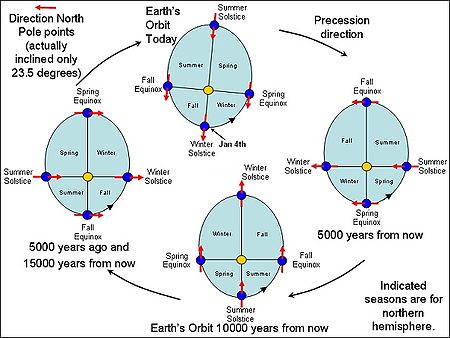- Apsidal precession
-
This article is about rotation of the orbit of a celestial body. For precession of the rotational axis, see precession of the equator. For change in orbital inclination, see precession of the ecliptic.
In celestial mechanics, perihelion precession, apsidal precession or orbital precession is the precession (rotation) of the orbit of a celestial body. More precisely it is the gradual rotation of the line joining the apsides of an orbit, which are the points of closest and farthest approach. Perihelion is the closest point to the Sun.
Contents
History
The ancient Greek astronomers[who?] noted the apsidal precession of the Moon's orbit; the precession of the solar apsides was discovered in the eleventh century by al-Zarqālī.[1] These remained difficult to account for until the 19th century.[citation needed]
Newton's theorem of revolving orbits
Newton derived an intriguing theorem showing that variations in the angular motion of a particle can be accounted for by the addition of a force that varies as the inverse cube of distance, without affecting the radial motion of a particle. Using a forerunner of the Taylor series, Newton generalized his theorem to all force laws provided that the deviations from circular orbits is small, which is valid for most planets in the Solar System. However, his theorem did not account for the apsidal precession of the Moon without giving up the inverse-square law of Newton's law of universal gravitation.
Perturbation theory
The expected rate of apsidal precession can be calculated more accurately using the methods of perturbation theory.
General relativity
An apsidal precession of the planet Mercury was noted by Urbain Le Verrier in the mid-19th century and accounted for by Einstein's theory of general relativity. To first approximation, this theory adds a central force that varies as the inverse fourth power of the distance.
Long-term climate
Because of apsidal precession the Earth's argument of periapsis slowly increases. Therefore the anomalistic year is slightly longer than the sidereal year. It takes about 112,000 years for the ellipse to revolve once relative to the fixed stars.
Because the anomalistic year is longer than the sidereal year while the tropical year (which calendars attempt to track) is shorter due to the precession of Earth's rotational axis, the two forms of 'precession' add. It takes about 21,000 years for the ellipse to revolve once relative to the vernal equinox, that is, for the perihelion to return to the same date (given a calendar that tracks the seasons perfectly). The dates of perihelion and of aphelion advance each year on this cycle, an average of 1 day every 58 years.
This interaction between the anomalistic and tropical cycle is important in the long-term climate variations on Earth, called the Milankovitch cycles. An equivalent is also known on Mars.
The figure illustrates the effects of precession on the northern hemisphere seasons, relative to perihelion and aphelion. Notice that the areas swept during a specific season changes through time. Orbital mechanics require that the length of the seasons be proportional to the swept areas of the seasonal quadrants, so when the orbital eccentricity is extreme, the seasons on the far side of the orbit may be substantially longer in duration.
Notes
- ^ Toomer, G. J. (1969), "The Solar Theory of az-Zarqāl: A History of Errors", Centaurus 14 (1): 306–36, Bibcode 1969Cent...14..306T, doi:10.1111/j.1600-0498.1969.tb00146.x, at pp. 314-17.
Categories:
Wikimedia Foundation. 2010.



